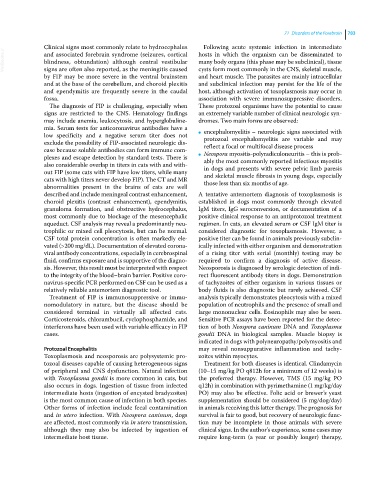Page 815 - Clinical Small Animal Internal Medicine
P. 815
71 Disorders of the Forebrain 783
Clinical signs most commonly relate to hydrocephalus Following acute systemic infection in intermediate
VetBooks.ir and associated forebrain syndrome (seizures, cortical hosts in which the organism can be disseminated to
many body organs (this phase may be subclinical), tissue
blindness, obtundation) although central vestibular
signs are often also reported, as the meningitis caused
and heart muscle. The parasites are mainly intracellular
by FIP may be more severe in the ventral brainstem cysts form most commonly in the CNS, skeletal muscle,
and at the base of the cerebellum, and choroid plexitis and subclinical infection may persist for the life of the
and ependymitis are frequently severe in the caudal host, although activation of toxoplasmosis may occur in
fossa. association with severe immunosuppressive disorders.
The diagnosis of FIP is challenging, especially when These protozoal organisms have the potential to cause
signs are restricted to the CNS. Hematology findings an extremely variable number of clinical neurologic syn-
may include anemia, leukocytosis, and hyperglobuline- dromes. Two main forms are observed:
mia. Serum tests for anticoronavirus antibodies have a encephalomyelitis – neurologic signs associated with
low specificity and a negative serum titer does not ● protozoal encephalomyelitis are variable and may
exclude the possibility of FIP‐associated neurologic dis- reflect a focal or multifocal disease process
ease because soluble antibodies can form immune com- Neospora myositis‐polyradiculoneuritis – this is prob-
plexes and escape detection by standard tests. There is ● ably the most commonly reported infectious myositis
also considerable overlap in titers in cats with and with- in dogs and presents with severe pelvic limb paresis
out FIP (some cats with FIP have low titers, while many and skeletal muscle fibrosis in young dogs, especially
cats with high titers never develop FIP). The CT and MR those less than six months of age.
abnormalities present in the brains of cats are well
described and include meningeal contrast enhancement, A tentative antemortem diagnosis of toxoplasmosis is
choroid plexitis (contrast enhancement), ependymitis, established in dogs most commonly through elevated
granuloma formation, and obstructive hydrocephalus, IgM titers, IgG seroconversion, or documentation of a
most commonly due to blockage of the mesencephalic positive clinical response to an antiprotozoal treatment
aqueduct. CSF analysis may reveal a predominantly neu- regimen. In cats, an elevated serum or CSF IgM titer is
trophilic or mixed cell pleocytosis, but can be normal. considered diagnostic for toxoplasmosis. However, a
CSF total protein concentration is often markedly ele- positive titer can be found in animals previously subclin-
vated (>200 mg/dL). Documentation of elevated corona- ically infected with either organism and demonstration
viral antibody concentrations, especially in cerebrospinal of a rising titer with serial (monthly) testing may be
fluid, confirms exposure and is supportive of the diagno- required to confirm a diagnosis of active disease.
sis. However, this result must be interpreted with respect Neosporosis is diagnosed by serologic detection of indi-
to the integrity of the blood–brain barrier. Positive coro- rect fluorescent antibody titers in dogs. Demonstration
navirus‐specific PCR performed on CSF can be used as a of tachyzoites of either organism in various tissues or
relatively reliable antemortem diagnostic tool. body fluids is also diagnostic but rarely achieved. CSF
Treatment of FIP is immunosuppressive or immu- analysis typically demonstrates pleocytosis with a mixed
nomodulatory in nature, but the disease should be population of neutrophils and the presence of small and
considered terminal in virtually all affected cats. large mononuclear cells. Eosinophils may also be seen.
Corticosteroids, chlorambucil, cyclophosphamide, and Sensitive PCR assays have been reported for the detec-
interferons have been used with variable efficacy in FIP tion of both Neospora caninum DNA and Toxoplasma
cases. gondii DNA in biological samples. Muscle biopsy is
indicated in dogs with polyneuropathy/polymyositis and
Protozoal Encephalitis may reveal nonsuppurative inflammation and tachy-
Toxoplasmosis and neosporosis are polysystemic pro- zoites within myocytes.
tozoal diseases capable of causing heterogeneous signs Treatment for both diseases is identical. Clindamycin
of peripheral and CNS dysfunction. Natural infection (10–15 mg/kg PO q812h for a minimum of 12 weeks) is
with Toxoplasma gondii is more common in cats, but the preferred therapy. However, TMS (15 mg/kg PO
also occurs in dogs. Ingestion of tissue from infected q12h) in combination with pyrimethamine (1 mg/kg/day
intermediate hosts (ingestion of encysted bradyzoites) PO) may also be effective. Folic acid or brewer’s yeast
is the most common cause of infection in both species. supplementation should be considered (5 mg/dog/day)
Other forms of infection include fecal contamination in animals receiving this latter therapy. The prognosis for
and in utero infection. With Neospora caninum, dogs survival is fair to good, but recovery of neurologic func-
are affected, most commonly via in utero transmission, tion may be incomplete in those animals with severe
although they may also be infected by ingestion of clinical signs. In the author’s experience, some cases may
intermediate host tissue. require long‐term (a year or possibly longer) therapy,

